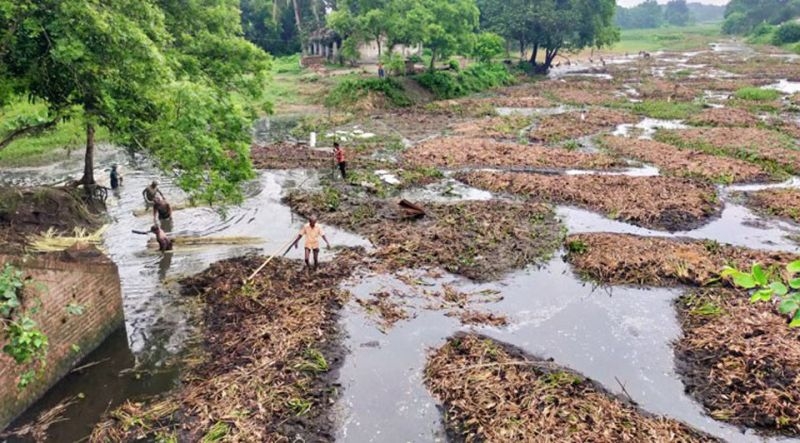- Cold wave disrupts life, livelihoods across northern Bangladesh |
- US to Exit 66 UN and Global Bodies Under New Policy Shift |
- LPG Supply Restored Nationwide After Traders End Strike |
- Stocks advance at both bourses; turnover improves |
- LCs surge for stable dollar, but settlement still sluggish |
Kurigram farmers struggle to process jute amid water crisis

Jute immersed after harvest in Rajshahi
Kurigram, July 24 - Once hailed as the ‘golden fiber’ of Bangladesh, jute is now fighting for survival in Fulbari upazila of Kurigram district, as a persistent water crisis stalls the crucial retting process, leaving farmers anxious and uncertain about their yields.
Despite fields brimming with ripe jute, many farmers are hesitant to begin harvesting.
Without sufficient water for retting -- the vital step in extracting fibre -- they fear their crops may rot, pushing them into heavy losses.
A recent visit to different areas of Fulbari revealed growing frustration among jute farmers.
Most local water bodies have dried up, offering little to no help for retting.
Only those residing near the Dharla, Baromasia and Neelkamal rivers have managed to begin harvesting and retting over the past week.
Others are left with no choice but to transport their jute to distant locations, some two to four kilometres away, in search of suitable water bodies. The extra labour and transport costs are adding to their woes.
“If there is no significant rainfall within the next week, we will be in serious trouble,” said a farmer, worried about their looming losses.
This is not a one-off incident. Many farmers say the problem has been recurring for years. Without proper retting facilities or assured water sources, their interest in cultivating jute is dwindling fast.
Adding to the crisis, farmers are also grappling with rising production costs and a lack of fair market prices for their jute.
“I cultivated jute on one and a half bighas of land but I can’t ret it due to a lack of rainwater,” said Badiuzzamal, a farmer from Anantapur village under Kashipur union.
Echoing the concern, Kishab Chandra Roy and Dhiren Chandra Roy from Gojerkuti area, said despite occasional rains over the past few days, it has not been enough to fill ponds or paddy fields for retting.
Farmers from various areas reported that while those near rivers have started retting, most agricultural fields remain dry, and nearby ponds are unable to serve the purpose.
Unless long-term measures are taken, they warned, interest in jute farming – once a major cash crop and pride of the region – may continue to decline.
Experts and farmers alike stressed that if the government is serious about building a polythene-free country, it must prioritise the jute sector through modern training, technical support and fair market policies.
Upazila Agriculture Officer Nilufa Yasmin said the Department of Agricultural Extension (DAE) has been providing advice and incentives to encourage jute cultivation.
“This year, farmers in six unions of the upazila have cultivated jute on 480 hectares of land. So far, around 75 hectares near river areas have been harvested and retted. With the onset of the monsoon, we hope heavy rainfall in the coming week will solve the water crisis for jute retting,” she added.
But until the rains come, Kurigram’s golden fibre remains in peril. - UNB

